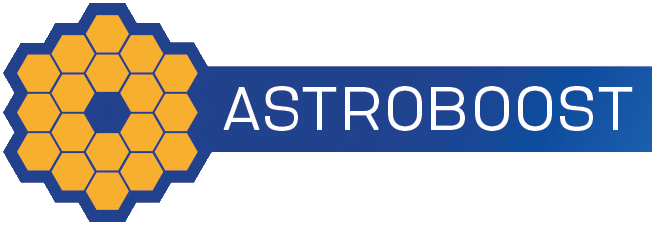Pilot Project & extension
The first AstroBoost project (2018-19) was led by the Royal Astronomical Society and funded by an STFC Spark Award.
Working with three partner societies, a pack of outreach resources and training was developed and then delivered over a six month evaluation period. The theme was the James Webb Space Telescope, and the Webb UK campaign was an important project partner.
After the success of the initial pilot, the Webb UK campaign commissioned an extension project (2020-2022) to a further nine societies across the UK.
This pilot project (2018-19) was run in partnership with Hampshire Astronomical Group, Guildford Astronomical Society, Newbury Astronomical Society and the Webb UK campaign.
The project allowed an equipment budget of £1,500 per society, to create matched kits of resources to support their outreach. These were themed to help them tell the story of Webb, which at that time was being assembled with continued work on the sunshield. Societies requested fully-documented resources that could be used flexibly in different contexts, but also brought together in a demo-led show suitable for groups of children aged 8-12yr.
Outreach resources:
Outreach kits contained all the necessities, from spare batteries to extended USB leads and a Powerpoint Advancer / laser-pointer. Evaluation forms and instructions were pre-printed and secured in folders. E-resources were provided on a USB stick, these including a Powerpoint show, pro-forma risk asssessments, extenal resources (including the Destination Space 2 handbook), and copies of all printed resources.
The star item in the kits was a Flir-C2 infrared camera (cost ~£450). This was the basis of many of the demonstrations. Designed for use by tradespeople, these cameras are very robust and suitable for use by children. They detect infrared within a range of wavelengths very similar to the MIRI instrument on the Webb Telescope. As MIRI was led from and assembled in the UK, this instrument was highlighted in the resources.
Other notable items included:
Pull-up banners (thanks to Steve Wilkins for the design, and also pin badges and training talk)
High-quality 3D-printed Webb telescope models
Webb-mirror jigsaw, where the completed jigsaw was the size of one real mirror segment
Infra-red transmitter/detector for transmitting music (thanks to Dave Hills for building these and the jigsaws)
‘Find the star’ activity with heated ballbearings in a covered print-tray
Bagged lego kits for making small Webb telecopes
For a full list of items, please see the project report. To find out more about the activities, download resources here.
Image credits: Mirror - Alastair Bruce; Camera - Guildford Astronomical Society; 3D model - NASA, ESA, CSA, and STScI (background) / AstroBoost; LEGO - AstroBoost.
Training and delivery
The resource kits were distributed at a training day held at Hampshire Astronomical Group’s Clanfield Observatory. Training included a talk by Webb Scientist Steve Wilkins (delivered by Zoom) and content about general science communication topics (including risk assessment, child protection, gender issues).
Over the next six months, each society ran its own in-house training for additional members, then delivered the activities to groups including schools, uniformed groups and adult evening classes. In total they engaged 980 people with the resources during this period. Use of resources continued past the end of the project, and for years beyond.
Extension project
Due to the success of the original project, the Webb UK campaign commisioned an extension project. The most successful items of kit from the pilot project were distributed to an additional nine societies across the UK. Societies were chosen for their high levels of outreach activity. The training day was due to take place in March 2020, but was delayed by the pandemic and finally moved online in November that year. By spring 2022 - despite Covid - the AstroBoost resources had been delivered to an audience of over 4,000 people.
The AstroBoost extension project participants were:
Airdrie Astronomical Association; Derby and District Astronomical Society; Liverpool Astronomical Society; Mansfield and Sutton Astronomical Society; Mid-Kent Astronomical Society; Northampton Natural History Society, Astronomy Section; DASH Astro; Norwich Astronomical Society; and Shropshire Astronomical Society. Luton Astronomical Society were trained by Northampton, and have also used the resources.





